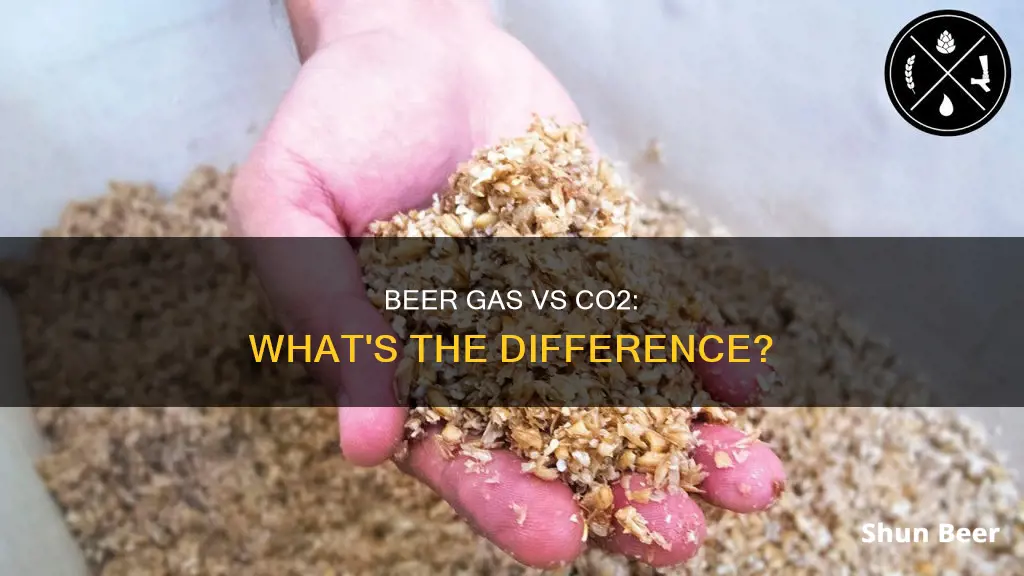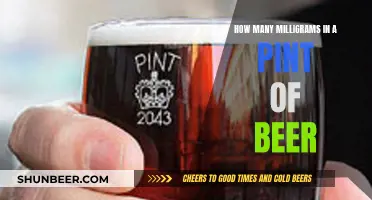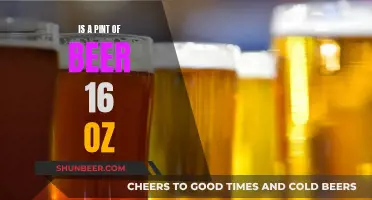
Beer gas and CO2 are used to propel beer out of a keg. The difference between the two is that beer gas is a blend of nitrogen (N2) and carbon dioxide (CO2), whereas CO2 is just carbon dioxide. The most common ratio for beer gas is 75% nitrogen and 25% CO2. This blend is used for nitro beers, such as stouts and ales, which have a creamy mouthfeel and less carbonation. CO2, on the other hand, is used to create carbonation in most draught beer systems, giving beer its characteristic fizz and contributing to its mouthfeel.
| Characteristics | Values |
|---|---|
| Beer Gas | A blend of nitrogen (N2) and carbon dioxide (CO2) |
| Most Common Ratio | 75% nitrogen and 25% CO2 |
| Used For | "Nitro" beers, such as stouts and ales |
| Effect | Creamy mouthfeel and less carbonation |
| Nitrogen Gas (N2) | Pure nitrogen is less soluble in beer than CO2 |
| Effect | Pushes beer out of the keg while maintaining the existing carbonation level |
| Used For | Beers that are intended to be less carbonated and smoother, such as stouts or nitro cold brew coffee |
| Carbon Dioxide (CO2) | Primarily used in most draught beer systems |
| Effect | Creates carbonation, giving beer its effervescence and a part of its mouthfeel |
| Argon | Not typically used in beer serving or preservation |
| Use Case | Wine preservation |
What You'll Learn

Beer gas is used for beers that should have a creamy mouthfeel
Beer gas is a blend of nitrogen (N2) and carbon dioxide (CO2). Typically, it consists of 75% nitrogen and 25% CO2, but the blend can vary. This mixture is used for beers that should have a creamy mouthfeel, such as stouts and ales, which are also known as "nitro" beers.
Nitrogen is less soluble in beer than CO2, so it doesn't dissolve as easily and create carbonation. Instead, it helps to push the beer out of the keg without over-carbonating it. This results in a cascading effect when poured, creating a thick, creamy head. Nitrogen also forms smaller, denser bubbles, giving the beer a smoother, creamier mouthfeel and less overall carbonation.
The choice of gas depends on the type of beer, the serving method, and the desired mouthfeel and flavour profile. While CO2 is used for more traditionally carbonated beers, beer gas is ideal for creating a creamy texture and mouthfeel.
EBC Beer Shipping: State-by-State Availability and Restrictions
You may want to see also

CO2 is for traditionally carbonated beers
CO2 is the traditional way of serving beer. The keg is filled with CO2 to push the beer into the tap. Since all beer contains CO2, using CO2 maintains the natural carbonation of the beer as it is served. The amount of CO2 in the beer already needs to be taken into account because nobody likes their beer too foamy or too flat.
CO2 is highly soluble in beer and creates carbonation, giving the beer its effervescence and contributing to its mouthfeel. However, using too much CO2 can over-carbonate the beer, potentially changing its flavour and making it feel more fizzy or prickly on the tongue.
CO2 is used in most draught beer systems because it occurs naturally during fermentation. It gives beer its characteristic head and provides a slight bittering in taste (a desirable quality in beer). CO2 also provides effervescence that helps lift the beer's aromas into the drinker's nose and palate.
Doppelbock vs. Bock Beer: Historical Differences Explained
You may want to see also

Nitrogen is for certain specialty beers
Nitrogen is used for certain specialty beers, such as stouts and ales, which are intended to have a less carbonated and smoother mouthfeel. Nitrogen is less soluble in beer than CO2, so it doesn't dissolve into the beer and create carbonation. Instead, it is used to push the beer out of the keg while maintaining the existing carbonation level. This results in a creamier texture and a more evenly distributed flavor.
The use of nitrogen in beer can also help to extend the shelf life of packaged beer and safeguard against harmful oxygenation, which can affect the taste, aroma, and quality of the beer. Additionally, nitrogen creates a unique, cascading pour when used in conjunction with widgets or nitrogen dosing machinery.
When choosing a gas for beer serving and preservation, it's important to consider the type of beer, the serving method, and the desired mouthfeel and flavor profile. While CO2 is typically used for more traditionally carbonated beers, nitrogen is ideal for certain specialty beers that benefit from a less fizzy and smoother texture.
What's the Real Difference in Draft Beer?
You may want to see also

Argon is used for wine preservation
Argon is preferred over nitrogen for wine preservation because it is less reactive, meaning the wine's flavours and aromas are less likely to be affected. Argon is also denser than nitrogen, making it faster at purging oxygen.
Beers Around the World: A Guide to Varieties
You may want to see also

The type of beer, serving method, and desired flavour profile will dictate the choice of gas
The gas used to dispense beer will have a significant impact on the flavour and texture of the brew. The ratio of nitrogen to carbon dioxide (CO2) in beer gas can be adjusted to create a creamy head, smooth mouthfeel, or a crisp, refreshing finish.
For example, nitrogen-infused beers, such as nitro stouts or Guinness, are popular because they create a unique flavour profile with an incredibly creamy head. The higher percentage of nitrogen in the beer gas gives the beer a smooth mouthfeel, enhancing sweeter flavours while balancing out bitter or astringent hoppy notes.
On the other hand, higher levels of carbon dioxide will provide more effervescence and give the beer a crisp finish. This is desirable for lighter styles like lagers or pale ales, where strong hop flavours are less prominent.
The type of tap system used to dispense the beer will also play a role in the choice of gas. Some systems allow brewers to adjust the mix of nitrogen and carbon dioxide, while others come pre-set with specific ratios for certain styles.
Additionally, the distance the beer needs to travel from the keg to the tap will determine the choice of gas. If pure CO2 is used at high pressure over a long distance, the beer will become over-carbonated as CO2 dissolves easily into the liquid. Nitrogen, on the other hand, is harder to dissolve and is therefore used as an alternative to prevent over-carbonation.
Ultimately, the choice of gas will depend on the specific beer, the serving method, and the desired flavour profile. Brewers can experiment with different ratios of nitrogen and carbon dioxide to find the perfect blend for their beer.
Explore the Difference Between Ales and Lagers in Beer
You may want to see also
Frequently asked questions
Beer gas is a blend of nitrogen (N2) and carbon dioxide (CO2), typically with 75% nitrogen and 25% CO2. CO2, on the other hand, is used on its own to carbonate beer.
The nitrogen in beer gas helps to push the beer out of the keg without over-carbonating it, which can change the flavour. It also creates a cascading effect when poured, resulting in a thick, creamy head.
Beer gas is used for "nitro" beers, such as stouts and ales, which are intended to have a creamy mouthfeel and less carbonation.
CO2 is primarily used for most draught beer systems as it dissolves into the beer to create carbonation, which is a key characteristic of many beers. However, for beers that require a creamier, less fizzy texture, beer gas is a better option.
Argon is not typically used for beer keg systems as it does not dissolve into the beer to create carbonation. It is, however, used for wine preservation.







